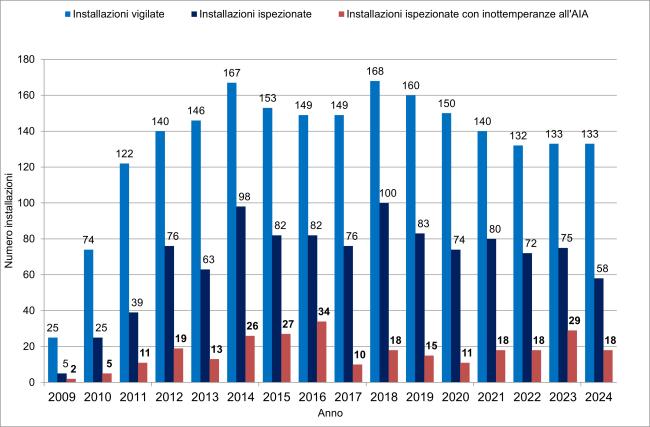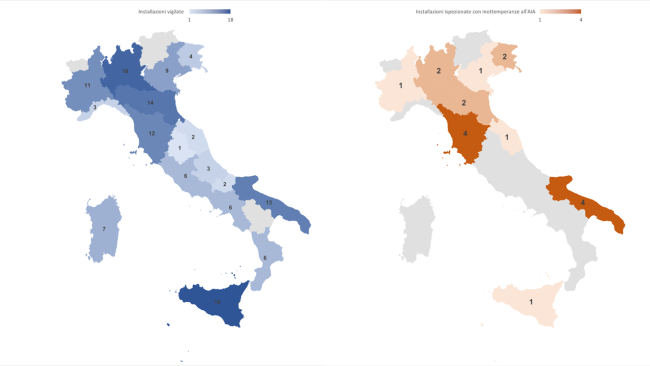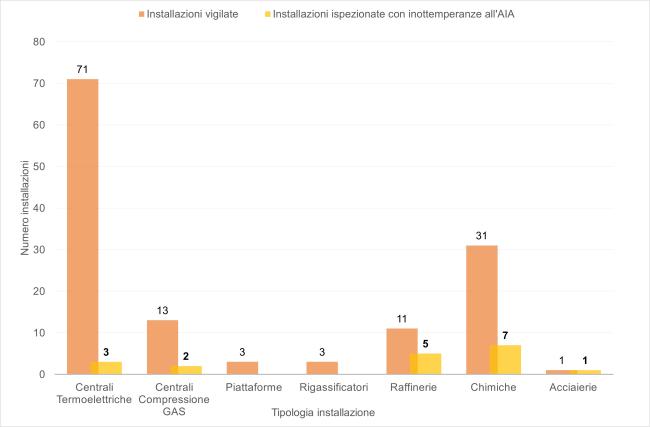Panel 1
Geneve Farabegoli, Paola Giorgioli, Federica Principato
2024 shows a number of state-controlled installations subject to Integrated Environmental Authorization (IAA) in line with 2023.
The information concerns the supervisory and control activity that ISPRA carries out, as a Control Body and with the support of Regional Regional Agencies for the territorially competent environment (ARPA/APPA), at industrial installations subject to compliance with the Integrated Environmental Authorization of State competence.
The positive trend recorded in the years between 2009 and 2014, underwent a slight reversal in 2015 for reasons independent of control activity, and then settled between 2016 and 2017, increasing in 2018 (recording the maximum number of supervised installations), and decreasing until 2022 and finally stabilizing between 2022 and finally stabilizing between 2022 and 2024.
In 2024 the total number of supervised installations was 133, with a number of installations inspected equal to 58, of which 18 were intoxicated with AIA or 31%.
The indicator provides information on the controls carried out by ISPRA at the operating installations subject to compliance with the Integrated Environmental Authorization (IAA) of state competence. The AIA is "the provision that authorizes the exercise of an installation included among those referred to in art.4, co. 4, lett. c), of Legislative Decree 152/2006 and s.m.i. or part of it under certain conditions that must ensure that the installation complies with the requirements of Title III-bis for the purpose of identifying the most suitable solutions for the pursuit of the objectives referred to in Article 4, paragraph 4 of the Treaty. An integrated environmental authorization may apply to one or more installations or parts of them that are located on the same site and managed by the same operator (see: art.5, co.1, lett. o-bis) of Legislative Decree 152/2006 and subsequent amendments.). In fact, the AIA, as an authorization for the operation of installations, contains requirements on the control of the various environmental matrices, as well as requirements on the adoption of the best available techniques for the management of industrial processes functional to the prevention and minimization of environmental impacts, including the emission limit values, as well as the monitoring and control plan and the reporting obligations by the operator. The operator of these installations, in compliance with the principles of the IPPC (Integrated Pollution Prevention and Control), is therefore obliged to carry out self-checking on emissions of all installations constituting the entire installation and to periodically transmit the results to the Control Entities. For plants of state competence, as referred to in Annex XII - Part II of Legislative Decree 152/2006, the Control Authority is ISPRA, which can make use of ARPA/APPA pursuant to art.29-decies co.11, and the competent Authority is the Ministry of Environment and Energy Safety (MASE).
The indicator provides information on the number of:
“supervised installations”, i.e. the number of installations authorised and supervised by the documentation submitted by the operator, irrespective of the annual scheduling of the on-site visit;
“insulated installations”, i.e. those installations that during the reference year were the subject of an inspection visit on site by the Control Authorities;
“installations inspected with in-compliance with the AIA”, i.e. the number of installations whose control activity found that they were found to be non-compliant with the AIA requirements and received a warning issued by the competent Authority (MASE) on the proposal of ISPRA. This indicator was used to highlight the number of intoxications both by type of activity and by Region on operating installations subject to AIA.
It should be noted that among the “inspected installations” is also included the installation of Acciaierie d’Italia S.p.A. (formerly ILVA) of Taranto which, being of national strategic interest, has been subject to four quarterly checks every year, given that they are planned.
Provide information on the supervisory and control activity carried out by ISPRA at the state-class installations.
The reference legislation is D. Lgs. 152/2006 and s.m.i., with the third corrective (D. Lgs.128/2010) has replaced the provisions of the D. Lgs. 59/2005 “Integral implementation of Directive 96/61/EC on integrated pollution prevention and control”, and a series of further updates, the last of which is the D. Lgs. “Implementation of Directive 2010/75/EU on industrial emissions (integrated pollution prevention and reduction)”. The latter has changed many aspects governed by D. Lgs.152/2006, in particular on the application of the sanctioning system to the AIA regime (Article 29-Quattuordecies). The legislation does not set objectives for the control of installations, nor does it contain detailed operating methods on the execution of the installations, but sets out criteria for the definition of the annual control plan. In addition, with the entry into force of the D. Lgs. 46/2014 come with Article 29-decies, co.11-ter, defined the programming criteria, in particular it is indicated that "... the period between two visits on site must not exceed one year for installations that present the highest risks, three years for installations that present less risk, six months for installations for installations for which the previous inspection has shown a serious non-compliance with the conditions of authorization".
Panel 2
To understand the indicator, reference can be made to the publication on the MASE website of the Annual Programming of checks for the reference year, as well as what is reported in the“Rapporto Controlli, Monitoraggi e Ispezioni Ambientali SNPA AIA/RIR relativi ai dati del 2023”, approvato dal Consiglio SNPA, Seduta del 11/10/2023 Doc. n. 35/2023 – ISBN 978-88-448-1165-5.
The limitation of the indicator is related to the information on the non-conformities detected of which the principle is known and not the term, being mostly linked to criminal proceedings that follow the process of the specific Prosecutor's Office.
Data quality assessment
ISPRA/ARPA/APPA
MASE (Ministero dell'ambiente e della Sicurezza Energetica)
SNPA (Sistema Nazionale per la protezione dell’ambiente)
National, Regional
2009-2024
Indicator assessment
The indicator was built on the basis of the information acquired from the MASE site for the number of active installations (in operation) and supervised, taking as a reference the administrative acts attesting to the supervisory and control activities and the data collected by ISPRA/ARPA/APPA for the number of installations inspected and for the percentage of installations unfinished to the AIA. The number of supervised installations includes all state installations subject to AIA, i.e. that they have obtained an integrated state environmental authorization, taking into account that, in some cases, the AIA is unique for the entire industrial installation (or complex), sometimes including directly connected plants (thermo-electric power plant or combined cycle gasification plant or similar) gasification.
In 2024 the total number of supervised installations was 133, equal to the previous year, with a number of inspected installations of 58 (including one for Acciaierie d’Italia S.p.A. which was the subject of 4 ordinary inspections), of which 18 were intoxicated with AIA (some inottemperance affected the same installation), i.e. 31% (Table 1, Figure 2).
The number of supervised installations has gone from 25 in 2009, the year in which the first supervisory and control activities were carried out by ISPRA, to 167 in 2014, it underwent a slight reversal in 2015 for independent reasons for the control activity, and then stabilized in 2016 and in 2017 (149 installations), increase in 2018 reaching the maximum number (168), and returning to decrease in the following years: in 2019 with 160 installations, in 2020 with 150 installations, in 2021.
The trend, on the whole, can be defined as stable because in the face of a greater number of supervised installations there has also been a significant increase in the number of installations inspected (from 5 in 2009 to 58 in 2024).
The number of intoxications detected following an inspection visit, indicated in terms of the number of warnings arranged by the competent Authority (MASE) (Figure 1), shows a regression of the value albeit with alignment compared to previous years (from 18 in 2021 and 2022, to 29 in 2023, up to 18 in 2024) linked to the specificity of each AIA. If we analyze the intoxications expressed as a percentage, with reference to the number of inspection visits conducted, it can be said that compared to the peak recorded in 2023 (39%) there is a decrease of 8 percentage points in 2024 while the average of intoxications recorded in the last 10 years is stable at around 25 %, excluding the values “extremities”, i.e. considering a range around the average value between 10% (Figure 2).





On the basis of the 133 installations authorized with state AIA, present and in operation on the national territory at 2024, there is a predominance of the number of thermal power plants (71) and chemical plants (31) compared to the other types (Figure 3).
In 2024, the number of in-contemperances by type of activity found that 7 chemical plants, 5 refineries, 3 thermal power plants, 2 gas compression stations and steelworks were distrusted. Despite the number of installations falling in the thermal power plant types and gas compression plants (a total of 84), only 5 warnings were notified. This is linked to the management of this type of installation that is less problematic than refineries and chemical plants that, with greater management complexity, have, as a whole, a higher number of warnings, equal to 12 out of 42 installations.
As shown in Figure 4, the largest number of installations is concentrated in the following regions: Sicily (18), Lombardy (16), Emilia-Romagna (14), Puglia (13), Tuscany (12), and Piedmont (11). In 2024, 9 regions of the 17 were distrusted, where installations with state AIA fall. We also wanted to return a graphic representation on the map of the aforementioned data (Figure 5), from which both the regions affected by installations with the state AIA and their geographical distribution are clearly identified, and the regions affected by the presence of installations that, following the inspections of ordinary / extraordinary control, carried out in 2024, were found to be undetecting in the operation.